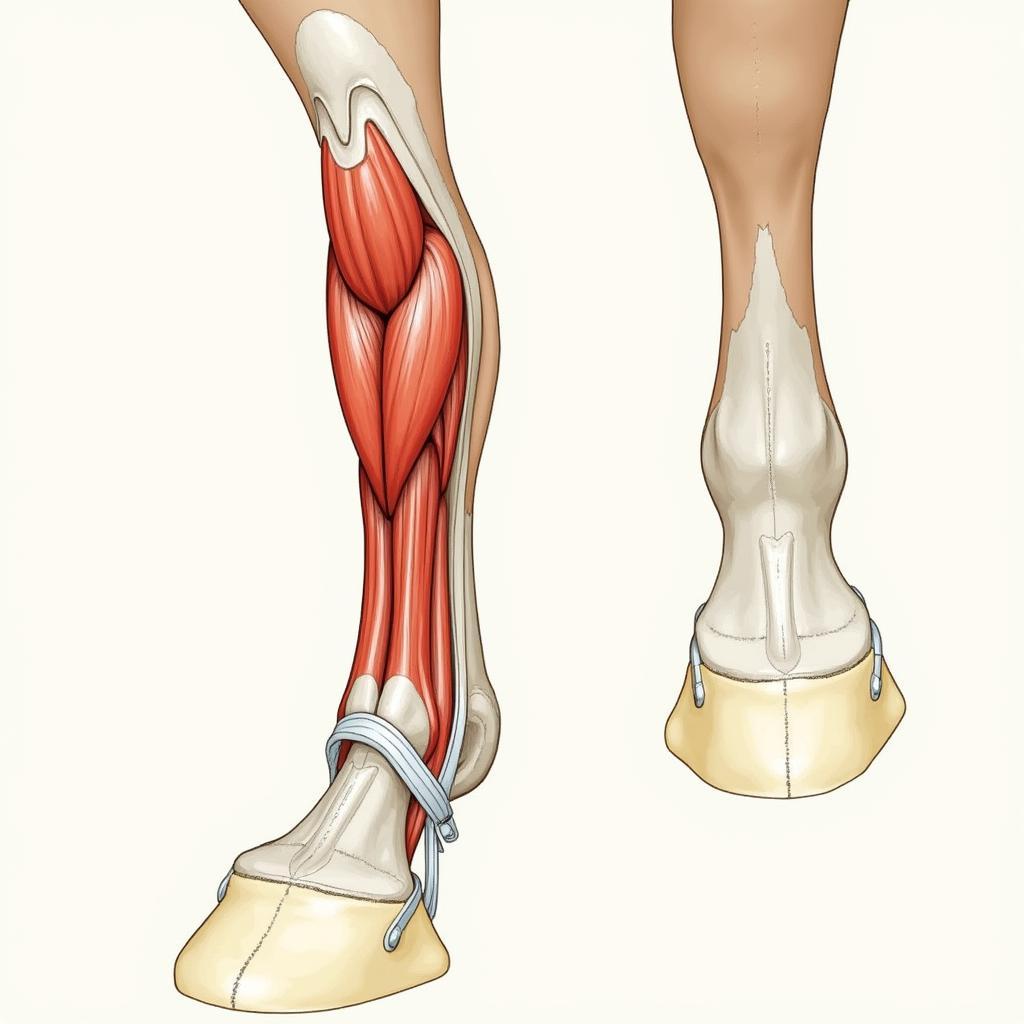The term “Horse Clutch” might seem confusing at first glance. After all, horses don’t drive cars! However, this phrase, often used interchangeably with “stay apparatus,” refers to a fascinating and essential aspect of equine anatomy and biomechanics. This intricate system of muscles, tendons, and ligaments allows horses to rest and sleep while standing up, a feat that seems impossible to us humans. Let’s delve into the fascinating world of the horse clutch and explore its significance in the life of these magnificent creatures.
How Does the Horse Clutch Work?
 Horse Anatomy: The Stay Apparatus
Horse Anatomy: The Stay Apparatus
The horse clutch is a marvel of evolutionary engineering. It primarily involves the horse’s forelegs and hind legs, enabling them to lock their joints in place with minimal muscular effort. Here’s a simplified breakdown of how it works:
- Forelegs: The “stay apparatus” in the forelegs primarily involves the suspensory ligament, superficial and deep digital flexor tendons, and the muscles associated with them. When a horse wants to rest, it slightly shifts its weight back, engaging this system. The tendons and ligaments act like a series of pulleys, holding the leg joints in a semi-flexed position.
- Hind Legs: The horse’s hind legs use a slightly different mechanism, relying on the reciprocal mechanism of the stifle and hock joints. Essentially, when the stifle joint locks, so does the hock, and vice versa. This interplay ensures that the hind legs remain stable and prevent the horse from collapsing.
Why is the Horse Clutch Important?
The horse clutch isn’t just a biological quirk; it’s a vital adaptation that provides horses with several advantages:
- Conservation of Energy: Standing for long periods can be tiring. The horse clutch allows horses to conserve energy by minimizing muscle use while resting. This is crucial for both wild and domesticated horses.
- Quick Escape: As prey animals, horses need to react quickly to danger. The horse clutch allows them to spring into action from a resting position, giving them a crucial head start against predators.
- Rest and Sleep: Just like us, horses need their sleep! However, unlike us, they can’t lie down for extended periods without risking potential respiratory issues. The horse clutch enables them to doze off lightly while standing, ensuring they get the rest they need.
Can Horses Sleep Lying Down?
While the horse clutch allows for standing rest, horses do lie down for deeper sleep, albeit for shorter periods. This deep sleep is essential for their physical and mental well-being. However, a horse lying down for too long can experience:
- Pressure Sores: A horse’s weight, concentrated on a smaller surface area when lying down, can restrict blood flow and lead to pressure sores.
- Respiratory Issues: Lying down for long can compress a horse’s lungs, potentially causing breathing difficulties.
A healthy horse will naturally adjust its sleeping positions, alternating between standing rest and short periods of lying down.
Problems Affecting the Horse Clutch
While the horse clutch is generally robust, certain conditions can affect its functionality:
- Injury: Trauma to the tendons, ligaments, or muscles involved in the horse clutch can impair its function.
- Inflammation: Conditions like tendonitis can cause pain and inflammation, making it difficult for a horse to engage the stay apparatus comfortably.
- Neurological Issues: In rare cases, problems with the nervous system can affect the horse’s ability to control the muscles necessary for the horse clutch.
If you notice any signs of lameness, reluctance to stand, or difficulty rising in your horse, consult a veterinarian immediately.
Understanding the Horse Clutch: Essential for Horse Owners
Knowing about the horse clutch provides valuable insight into the unique physiology of horses. This knowledge helps horse owners:
- Provide Appropriate Care: Understanding how horses rest influences management practices. Providing ample space, comfortable bedding, and a safe environment are crucial for healthy resting habits.
- Recognize Potential Problems: Being aware of the horse clutch and its functions helps owners identify potential issues early and seek veterinary attention when needed.
- Appreciate the Horse’s Design: The horse clutch is a testament to the incredible adaptations of these animals. Recognizing this intricate system deepens our appreciation for their resilience and ability to thrive.
The next time you see a horse seemingly effortlessly resting while standing, remember the incredible horse clutch working behind the scenes. This fascinating mechanism is just one of the many reasons why horses continue to captivate and amaze us.
Frequently Asked Questions about the Horse Clutch
1. Can all horses use the horse clutch?
Yes, the horse clutch is a natural mechanism present in all healthy horses.
2. Do horses dream while standing up using the horse clutch?
While horses can doze lightly while standing, they typically only experience deep sleep and dreaming when lying down.
3. Can the horse clutch be trained or improved?
No, the horse clutch is an involuntary physiological mechanism and cannot be trained or improved.
4. How long can a horse stand using the horse clutch?
Horses can stand for incredibly long periods, sometimes days or even weeks, with the help of the horse clutch.
5. What should I do if my horse seems to have trouble standing or appears lame?
Contact your veterinarian immediately. Difficulties standing or signs of lameness could indicate a problem with the horse clutch or other health issues.
For more information on horse care and related topics, explore our other articles:
Don’t hesitate to reach out to us for any inquiries or assistance. Contact us at Phone Number: 0772127271, Email: [email protected] or visit our address: QGM2+WX2, Vị Trung, Vị Thuỷ, Hậu Giang, Việt Nam. Our dedicated customer support team is available 24/7 to assist you.